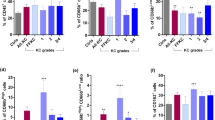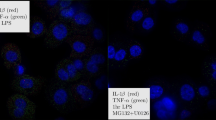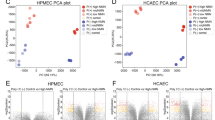Abstract
Purpose
This study assessed the anti-inflammatory effect and mechanism of action of hinokitiol in human corneal epithelial (HCE) cells.
Methods
HCE cells were incubated with different concentrations of hinokitiol or dimethylsulfoxide (DMSO), which served as a vehicle control. Cell viability was evaluated using Cell Counting Kit-8 (CCK-8) assay. After polyriboinosinic:polyribocytidylic acid (poly(I:C)) stimulus, cells with or without hinokitiol were evaluated for the mRNA and protein levels of interleukin-8 (IL-8), interleukin-6 (IL-6), and interleukin-1β (IL-1β) using real-time PCR analysis and an enzyme-linked immunosorbent assay (ELISA), respectively. Nuclear and cytoplasmic levels of nuclear factor kappa B (NF-κB) p65 protein and an inhibitor of NF-κB α (IκBα) were evaluated using western blotting.
Results
There were no significant differences among the treatment concentrations of hinokitiol compared with cells incubated in medium only. Incubating with 100 μM hinokitiol significantly decreased the mRNA levels of IL-8 to 58.77±10.41% (P<0.01), IL-6 to 64.64±12.71% (P<0.01), and IL-1β to 54.19±8.10% (P<0.01) compared with cells stimulated with poly(I:C) alone. The protein levels of IL-8, IL-6, and IL-1β had similar trend. Further analysis revealed that hinokitiol maintained the levels of IκBα and significantly reduced NF-κB p65 subunit translocation to the nucleus which significantly inhibiting the activation of the NF-κB signal pathway.
Conclusion
Hinokitiol showed a significant protective effect against ocular surface inflammation through inhibiting the NF-κB pathway, which may indicate the possibility to relieve the ocular surface inflammation of dry eye syndrome (DES).
Similar content being viewed by others
Log in or create a free account to read this content
Gain free access to this article, as well as selected content from this journal and more on nature.com
or
References
Javadi MA, Feizi S . Dry eye syndrome. J Ophthalmic Vis Res 2011; 6 (3): 192–198.
Group IDEWS. The definition and classification of dry eye disease: report of the Definition and Classification Subcommittee of the International Dry Eye WorkShop (2007). Ocul Surf. 2007; 5 (2): 75–92.
Nichols KK, Foulks GN, Bron AJ, Glasgow BJ, Dogru M, Tsubota K et al. The international workshop on meibomian gland dysfunction: executive summary. Invest Ophthalmol Vis Sci 2011; 52 (4): 1922–1929.
Gayton JL . Etiology, prevalence, and treatment of dry eye disease. Clin Ophthalmol 2009; 3: 405–412.
Lee AJ, Lee J, Saw SM, Gazzard G, Koh D, Widjaja D et al. Prevalence and risk factors associated with dry eye symptoms: a population based study in Indonesia. Br J Ophthalmol 2002; 86 (12): 1347–1351.
Gupta N, Prasad I, Jain R, D'Souza P . Estimating the prevalence of dry eye among Indian patients attending a tertiary ophthalmology clinic. Ann Trop Med Parasitol 2010; 104 (3): 247–255.
Dana MR, Hamrah P . Role of immunity and inflammation in corneal and ocular surface disease associated with dry eye. Adv Exp Med Biol. 2002; 506 (Pt B): 729–738.
Fabre EJ, Bureau J, Pouliquen Y, Lorans G . Binding sites for human interleukin 1 alpha, gamma interferon and tumor necrosis factor on cultured fibroblasts of normal cornea and keratoconus. Curr Eye Res 1991; 10 (7): 585–592.
De Paiva CS, Corrales RM, Villarreal AL, Farley WJ, Li DQ, Stern ME et al. Corticosteroid and doxycycline suppress MMP-9 and inflammatory cytokine expression, MAPK activation in the corneal epithelium in experimental dry eye. Exp Eye Res 2006; 83 (3): 526–535.
Luo L, Li DQ, Doshi A, Farley W, Corrales RM, Pflugfelder SC . Experimental dry eye stimulates production of inflammatory cytokines and MMP-9 and activates MAPK signaling pathways on the ocular surface. Invest Ophthalmol Vis Sci 2004; 45 (12): 4293–4301.
Niederkorn JY, Stern ME, Pflugfelder SC, De Paiva CS, Corrales RM, Gao J et al. Desiccating stress induces T cell-mediated Sjogren's Syndrome-like lacrimal keratoconjunctivitis. J Immunol 2006; 176 (7): 3950–3957.
Morita Y, Matsumura E, Okabe T, Fukui T, Shibata M, Sugiura M et al. Biological activity of alpha-thujaplicin, the isomer of hinokitiol. Biol Pharm Bull 2004; 27 (6): 899–902.
Krenn BM, Gaudernak E, Holzer B, Lanke K, Van Kuppeveld FJ, Seipelt J . Antiviral activity of the zinc ionophores pyrithione and hinokitiol against picornavirus infections. J Virol 2009; 83 (1): 58–64.
Baba T, Nakano H, Tamai K, Sawamura D, Hanada K, Hashimoto I et al. Inhibitory effect of beta-thujaplicin on ultraviolet B-induced apoptosis in mouse keratinocytes. J Invest Dermatol 1998; 110 (1): 24–28.
Inamori Y, Tsujibo H, Ohishi H, Ishii F, Mizugaki M, Aso H et al. Cytotoxic effect of hinokitiol and tropolone on the growth of mammalian cells and on blastogenesis of mouse splenic T cells. Biol Pharm Bull 1993; 16 (5): 521–523.
Byeon SE, Lee YG, Kim JC, Han JG, Lee HY, Cho JY . Hinokitiol, a natural tropolone derivative, inhibits TNF-alpha production in LPS-activated macrophages via suppression of NF-kappaB. Planta Med 2008; 74 (8): 828–833.
Shih YH, Lin DJ, Chang KW, Hsia SM, Ko SY, Lee SY et al. Evaluation physical characteristics and comparison antimicrobial and anti-inflammation potentials of dental root canal sealers containing hinokitiol in vitro. PLoS One 2014; 9 (6): e94941.
Ye J, Wu H, Zhang H, Wu Y, Yang J, Jin X et al. Role of benzalkonium chloride in DNA strand breaks in human corneal epithelial cells. Graefes Arch Clin Exp Ophthalmol 2011; 249 (11): 1681–1687.
Ueta M, Hamuro J, Kiyono H, Kinoshita S . Triggering of TLR3 by polyI:C in human corneal epithelial cells to induce inflammatory cytokines. Biochem Biophys Res Commun 2005; 331 (1): 285–294.
Kontos CK, Papadopoulos IN, Fragoulis EG, Scorilas A . Quantitative expression analysis and prognostic significance of L-DOPA decarboxylase in colorectal adenocarcinoma. Br J Cancer 2010; 102 (9): 1384–1390.
Schaumberg DA, Sullivan DA, Buring JE, Dana MR . Prevalence of dry eye syndrome among US women. Am J Ophthalmol 2003; 136 (2): 318–326.
Friedman NJ . Impact of dry eye disease and treatment on quality of life. Curr Opin Ophthalmol 2010; 21 (4): 310–316.
Jumblatt JE, Jumblatt MM . Regulation of ocular mucin secretion by P2Y2 nucleotide receptors in rabbit and human conjunctiva. Exp Eye Res 1998; 67 (3): 341–346.
Li Y, Kuang K, Yerxa B, Wen Q, Rosskothen H, Fischbarg J . Rabbit conjunctival epithelium transports fluid, and P2Y2(2) receptor agonists stimulate Cl(-) and fluid secretion. Am J Physiol Cell Physiol 2001; 281 (2): C595–C602.
Murakami T, Fujihara T, Horibe Y, Nakamura M . Diquafosol elicits increases in net Cl- transport through P2Y2 receptor stimulation in rabbit conjunctiva. Ophthalmic Res 2004; 36 (2): 89–93.
Koh S, Ikeda C, Takai Y, Watanabe H, Maeda N, Nishida K . Long-term results of treatment with diquafosol ophthalmic solution for aqueous-deficient dry eye. Jpn J Ophthalmol 2013; 57 (5): 440–446.
Takamura E, Tsubota K, Watanabe H, Ohashi Y . A randomised, double-masked comparison study of diquafosol versus sodium hyaluronate ophthalmic solutions in dry eye patients. Br J Ophthalmol 2012; 96 (10): 1310–1315.
Koh S, Maeda N, Ikeda C, Oie Y, Soma T, Tsujikawa M et al. Effect of diquafosol ophthalmic solution on the optical quality of the eyes in patients with aqueous-deficient dry eye. Acta Ophthalmol 2014; 92 (8): e671–e675.
Yamaguchi M, Nishijima T, Shimazaki J, Takamura E, Yokoi N, Watanabe H et al. Clinical usefulness of diquafosol for real-world dry eye patients: a prospective, open-label, non-interventional, observational study. Adv Ther 2014; 31 (11): 1169–1181.
Kamiya K, Nakanishi M, Ishii R, Kobashi H, Igarashi A, Sato N et al. Clinical evaluation of the additive effect of diquafosol tetrasodium on sodium hyaluronate monotherapy in patients with dry eye syndrome: a prospective, randomized, multicenter study. Eye (Lond) 2012; 26 (10): 1363–1368.
Kinoshita S, Awamura S, Oshiden K, Nakamichi N, Suzuki H, Yokoi N . Rebamipide (OPC-12759) in the treatment of dry eye: a randomized, double-masked, multicenter, placebo-controlled phase II study. Ophthalmology 2012; 119 (12): 2471–2478.
Urashima H, Okamoto T, Takeji Y, Shinohara H, Fujisawa S . Rebamipide increases the amount of mucin-like substances on the conjunctiva and cornea in the N-acetylcysteine-treated in vivo model. Cornea 2004; 23 (6): 613–619.
Kinoshita S, Awamura S, Nakamichi N, Suzuki H, Oshiden K, Yokoi N . A multicenter, open-label, 52-week study of 2% rebamipide (OPC-12759) ophthalmic suspension in patients with dry eye. Am J Ophthalmol 2014; 157 (3): 576–83 e1.
Kinoshita S, Oshiden K, Awamura S, Suzuki H, Nakamichi N, Yokoi N . A randomized, multicenter phase 3 study comparing 2% rebamipide (OPC-12759) with 0.1% sodium hyaluronate in the treatment of dry eye. Ophthalmology 2013; 120 (6): 1158–1165.
Koh S, Inoue Y, Sugmimoto T, Maeda N, Nishida K . Effect of rebamipide ophthalmic suspension on optical quality in the short break-up time type of dry eye. Cornea 2013; 32 (9): 1219–1223.
Jones DT, Monroy D, Ji Z, Atherton SS, Pflugfelder SC . Sjogren's syndrome: cytokine and Epstein-Barr viral gene expression within the conjunctival epithelium. Invest Ophthalmol Vis Sci 1994; 35 (9): 3493–3504.
Solomon A, Dursun D, Liu Z, Xie Y, Macri A, Pflugfelder SC . Pro- and anti-inflammatory forms of interleukin-1 in the tear fluid and conjunctiva of patients with dry-eye disease. Invest Ophthalmol Vis Sci 2001; 42 (10): 2283–2292.
Yoon KC, Jeong IY, Park YG, Yang SY . Interleukin-6 and tumor necrosis factor-alpha levels in tears of patients with dry eye syndrome. Cornea 2007; 26 (4): 431–437.
Fini ME, Girard MT . Expression of collagenolytic/gelatinolytic metalloproteinases by normal cornea. Invest Ophthalmol Vis Sci 1990; 31 (9): 1779–1788.
de Paiva CS, Pflugfelder SC . Rationale for anti-inflammatory therapy in dry eye syndrome. Arq Bras Oftalmol 2008; 71 (6 Suppl): 89–95.
Pflugfelder SC . Antiinflammatory therapy for dry eye. Am J Ophthalmol 2004; 137 (2): 337–342.
McCabe E, Narayanan S . Advancements in anti-inflammatory therapy for dry eye syndrome. Optometry 2009; 80 (10): 555–566.
Barber LD, Pflugfelder SC, Tauber J, Foulks GN . Phase III safety evaluation of cyclosporine 0.1% ophthalmic emulsion administered twice daily to dry eye disease patients for up to 3 years. Ophthalmology 2005; 112 (10): 1790–1794.
Yoshida I, Azuma M . An alternative receptor to poly I:C on cell surfaces for interferon induction. Microbiol Immunol 2013; 57 (5): 329–333.
Jayakumar T, Hsu WH, Yen TL, Luo JY, Kuo YC, Fong TH et al. Hinokitiol, a natural tropolone derivative, offers neuroprotection from thromboembolic stroke in vivo. Evid Based Complement Alternat Med 2013; 2013: 840487.
Vijmasi T, Chen FY, Chen YT, Gallup M, McNamara N . Topical administration of interleukin-1 receptor antagonist as a therapy for aqueous-deficient dry eye in autoimmune disease. Mol Vis 2013; 19: 1957–1965.
Amparo F, Dastjerdi MH, Okanobo A, Ferrari G, Smaga L, Hamrah P et al. Topical interleukin 1 receptor antagonist for treatment of dry eye disease: a randomized clinical trial. JAMA Ophthalmol 2013; 131 (6): 715–723.
Vallabhapurapu S, Karin M . Regulation and function of NF-kappaB transcription factors in the immune system. Annu Rev Immunol 2009; 27: 693–733.
Siddique I, Khan I . Mechanism of regulation of Na-H exchanger in inflammatory bowel disease: role of TLR-4 signaling mechanism. Dig Dis Sci 2011; 56 (6): 1656–1662.
Acknowledgements
We thank Ying-Gang Yan, PhD, Yu Wu, PhD, Bin Zhang, PhD (Department of Neurobiology in Zhejiang University) for technical assistance in sample testing and statistical analysis. This study was supported by grant 81070756 from the Natural Science Foundation of China, by grant 2012BAI08B01 from the National Twelfth Five-Year Plan for Science and Technology Support of China, by grant NCET-11-0161 from the Program for New-Century Excellent Talents in Universities of China, by the Zhejiang Provincial Program for Cultivation of High-level Innovative Health Talents, by grant 2012C13023-2 from the Specialized Key Science and Technology Foundation of Zhejiang Provincial Science and Technology Department, and by grant 2011ZDA014 from the Zhejiang Provincial Key Project of Medicine and Health.
Author information
Authors and Affiliations
Corresponding author
Ethics declarations
Competing interests
The authors declare no conflicts of interest.
Rights and permissions
About this article
Cite this article
Ye, J., Xu, YF., Lou, LX. et al. Anti-inflammatory effects of hinokitiol on human corneal epithelial cells: an in vitro study. Eye 29, 964–971 (2015). https://doi.org/10.1038/eye.2015.62
Received:
Accepted:
Published:
Issue date:
DOI: https://doi.org/10.1038/eye.2015.62
This article is cited by
-
Hinokitiol-iron complex is a ferroptosis inducer to inhibit triple-negative breast tumor growth
Cell & Bioscience (2023)
-
Nerve growth factor inhibits TLR3-induced inflammatory cascades in human corneal epithelial cells
Journal of Inflammation (2019)



